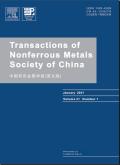不同温度下选择性激光熔化Al - Mg - Mn - Sc - Zr合金的显微组织和力学性能
IF 4.7
1区 材料科学
Q1 METALLURGY & METALLURGICAL ENGINEERING
Transactions of Nonferrous Metals Society of China
Pub Date : 2025-04-01
DOI:10.1016/S1003-6326(24)66733-6
引用次数: 0
摘要
采用选择性激光熔化(SLM)法制备了Al−3.51Mg−0.42Mn−0.76Sc−0.40Zr (wt.%)合金。研究了合金在300℃和325℃退火6 h后的力学性能和显微组织。SLM合金的抗拉强度为339 MPa,屈服强度为213 MPa,延伸率为24%。在300℃下退火6 h后,合金的抗拉强度和屈服强度分别提高到518 MPa和505 MPa,伸长率下降到13%。在325℃下退火6 h后,合金的屈服强度降至483 MPa。合金在300℃和325℃退火后晶粒尺寸没有明显增大,但Mg元素的偏析明显减少。合金基体中析出纳米级Al3(Sc,Zr)相,其平均尺寸随退火温度的升高而增大。因此,退火后SLM铝合金的强度提高主要归因于Al3(Sc,Zr)的析出强化,强化机制主要为位错切削机制。当退火温度过高时,Al3(Sc,Zr)晶粒的粗化导致强度降低。本文章由计算机程序翻译,如有差异,请以英文原文为准。
Microstructure and mechanical properties of selective laser melting Al−Mg−Mn−Sc−Zr alloy annealed at different temperatures
Al−3.51Mg−0.42Mn−0.76Sc−0.40Zr (wt.%) alloy was prepared by selective laser melting (SLM) method. The mechanical properties and microstructure of the alloy after annealing at 300 °C or 325 °C for 6 h were studied. The tensile strength, yield strength and elongation of the SLM alloy were 339 MPa, 213 MPa and 24%, respectively. After annealing at 300 °C for 6 h, the tensile and yield strength of the alloy were increased to 518 MPa and 505 MPa, respectively, and the elongation decreased to 13%. After annealing at 325 °C for 6 h, the yield strength of the alloy was reduced to 483 MPa. The grain size of the alloy after annealing at 300 °C and 325 °C did not grow significantly, but the segregation of Mg element was significantly reduced. Nanoscale Al3(Sc,Zr) phase was precipitated from the alloy matrix, and its average size increased with the increase of annealing temperature. Therefore, the strength improvement of the annealed SLM aluminum alloy was mainly attributed to the precipitation strengthening of Al3(Sc,Zr), and the strengthening mechanism was mainly dislocation cutting mechanism. When the annealing temperature was too high, the coarsening of Al3(Sc,Zr) particles caused the strength to decrease.
求助全文
通过发布文献求助,成功后即可免费获取论文全文。
去求助
来源期刊
CiteScore
7.40
自引率
17.80%
发文量
8456
审稿时长
3.6 months
期刊介绍:
The Transactions of Nonferrous Metals Society of China (Trans. Nonferrous Met. Soc. China), founded in 1991 and sponsored by The Nonferrous Metals Society of China, is published monthly now and mainly contains reports of original research which reflect the new progresses in the field of nonferrous metals science and technology, including mineral processing, extraction metallurgy, metallic materials and heat treatments, metal working, physical metallurgy, powder metallurgy, with the emphasis on fundamental science. It is the unique preeminent publication in English for scientists, engineers, under/post-graduates on the field of nonferrous metals industry. This journal is covered by many famous abstract/index systems and databases such as SCI Expanded, Ei Compendex Plus, INSPEC, CA, METADEX, AJ and JICST.

 求助内容:
求助内容: 应助结果提醒方式:
应助结果提醒方式:


